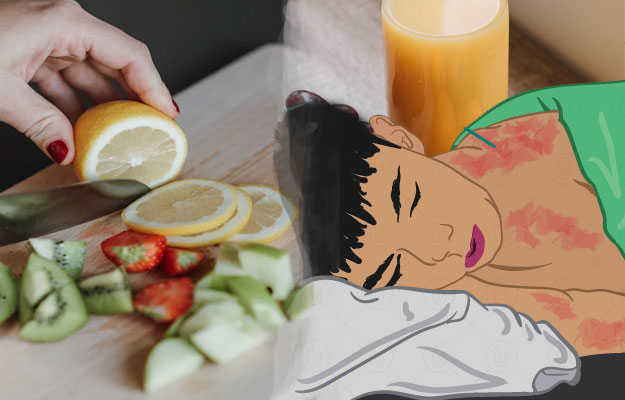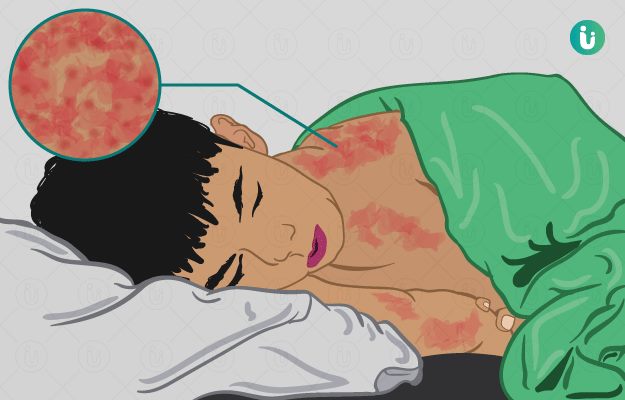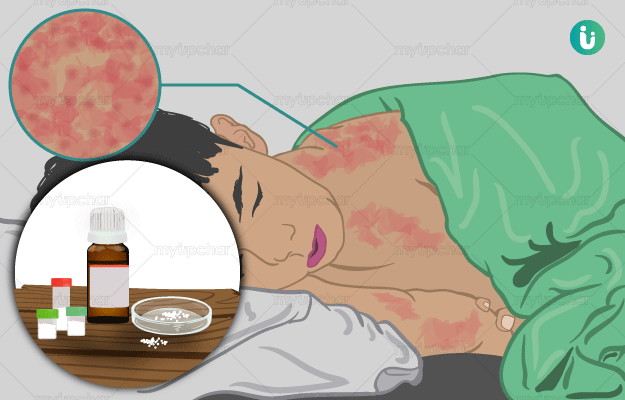Measles is an infectious disease caused by the measles morbillivirus. A safe and effective vaccine is widely available, but it still leads to more than a hundred thousand deaths globally, mostly children.
Symptoms appear within 7 to 14 days after contact with the virus and typically include high fever, cough, runny nose, and watery eyes. Koplik spot (white swelling in the mouth) or rash is a common symptom that appears 3 to 5 days after the first symptoms.
(Read more: Measles antibody test)
Taking different types of diet at different stages of this disease can be helpful in managing the symptoms, preventing complications and aids in fast recovery. Read on to know what to eat and not to eat for a measles patient. You’ll also find two diet plans - one for the first week of the disease, and the second for after that.
- Take food rich in vitamin A in measles
- Drink enough fluids to avoid dehydration in measles
- What else to eat in measles: food for fast recovery
- What not to eat in measles
- Indian diet plan for measles
Take food rich in vitamin A in measles
Vitamin A supplements are prescribed for all measles patients - two doses that are to be taken a day apart. This addresses the low levels of vitamin A that are commonly observed during measles. Even if the patient is generally well-nourished, a vitamin A supplement is a must as it reduces the chances of complications (eye damage or blindness) and even death
(Read more: Vitamin A test)
In addition to the supplement, the patient can also be given foods rich in vitamin A such as all red, yellow and orange fruits and vegetables. Commonly available ones are carrot, pumpkin, sweet potatoes, papaya etc.
(Read more: Vitamin A deficiency)
Drink enough fluids to avoid dehydration in measles
Due to fever, dehydration is very common during measles. Besides taking an oral rehydration solution, coconut water, fruit juices, buttermilk are also helpful as they are easy to digest and loaded with electrolytes and vital nutrients.
(Read more: Dehydration in children)
What else to eat in measles: food for fast recovery
Once you have ensured that the patient’s requirement of vitamin A and fluids has been met, you can proceed to add other foods to their diet to better manage various health consequences of the disease like loss of appetite (fruit juices will help), low energy (give porridge), and foods to boost immunity to aid faster recovery.
Food to compensate for loss of appetite
Due to loss of appetite during measles, the patient is not able to eat much. With these simple steps, you can fulfil their nutritional requirements:
- Give the patient juices of fruits like orange and lemon with glucose and vegetables or lentil soup.
- Gradually, the patient can start eating fruits and a balanced diet, which should include lots of green vegetables and fruits, to boost the immune system. You can start solid meals for them with mashed potatoes, porridge, and mashed rice as they are easy to digest.
- The patient can be given lots of warm water to drink, as this flushes toxins out of the system. For better results, have warm water in the mornings on an empty stomach and in the evenings.
(Read more: How to increase appetite in kids)
Food for increasing energy levels
Fever is the main symptom of measles. Because of fever, the patient can also experience low energy levels and loss of taste. In this condition, their diet should be easy to digest, and energy-dense foods should be added to it like mixed vegetable khichdi, porridge, tapioca pearl (sabudana), rice, suji kheer. To enhance the taste and flavour of food you can add fresh herbs like basil (tulsi), coriander, garlic, ginger and lemon.
Protein can be helpful for muscle and weight loss
Due to fever, weight and muscle loss are visible during this disease. To maintain a healthy weight and muscles, try to add easy-to-digest protein-rich foods in each meal such as lentil soup, chickpea salad, daal, sambhar, and scrambled eggs.
Add Vitamin C rich food to the diet
Vitamin C is a well-known antiviral agent, especially in measles. It is also known as a strong antioxidant that helps with skin conditions such as rashes, which is common in this disease. Two to three types of citrus fruits like oranges, sweet lime, and lemon every day should do the trick.
Immunity boosting food
A strong immune system can help with a fast recovery. Foods rich in different vitamins, minerals, and antioxidants can be helpful. Turmeric, nutmeg, ginger, clove, black pepper, sweet basil leaves are known for being rich in these nutrients. You can add them to herbal tea (kadha), curry, or soup. All colourful and seasonal fruits and vegetables are a great source of these nutrients as well. You can have them as fruit juice, shake, vegetable juice, or soup.
(Read more: Foods for increasing immunity)
Are you also troubled by obesity and are not able to lose weight even after a lot of efforts, then start using myUpchar Ayurveda Medarodh Weight Control Tablet today and control your weight.
What not to eat in measles
The most important thing to remember is that the patient should not be given any foods or drinks that may lead to dehydration. The patient should not consume caffeinated and sweet drinks. These drinks can cause dehydration in the body. Replace your caffeinated drinks (tea, coffee, green tea, energy drinks) with other drinks such as turmeric tea, non-caffeine green tea, lemon water, or juice.
Also, it is best to avoid foods with high levels of refined carbohydrates, saturated fats, sodium, and preservatives that can lower immunity, which can delay the recovery of the patient, such as these:
- Fried food: Samosa, kachori, pakode etc.
- Junk food: pizza, burger, etc.
- Processed food: jam, jelly, ready-to-eat food
- Heavy meats: mutton, pork and other red meat
- Trans fats: dalda, butter, processed cheese
- Carbonated drinks: cola drinks, etc.
- Sweets: cakes, pastry, mithai
- Salty snacks: namkeen etc.
Indian diet plan for measles
Here are two Indian diet plans that incorporate all the advice given above. The first diet plan is for the first week after the appearance of the symptoms, and the second can be followed thereafter.
If any of the foods are not to your liking, you can discuss it with your nutritionist and get a customised diet plan made that is consistent with the advice given above:
Measles diet plan for days 1 to 7
This is the diet plan for the first 7 days of measles. The key here is that as the patient will not be able to eat, a simple liquid or semi-liquid diet is important:
- Early morning: water (1 glass) + soaked raisins (8-10)
- Breakfast: daliya with moong dal and vegetable (1-2 bowl)
- Mid meal: orange or grapefruit juice (1 glass) with glucose (1-2 teaspoon)
- Lunch: khichdi (1 bowl) + spinach kadhi (1 bowl)
- Evening: coconut water (1) + roasted fox nuts (1 bowl)
- Dinner: vegetable soup (1 bowl) + mashed rice (1 bowl) + mashed potato (1 bowl) + moong dal (1 bowl)
- Bedtime: turmeric milk (1 glass)
Measles diet plan for after day 7
This diet plan can be followed after the 7th day of diagnosis or when you can see that patient is able to eat solid foods:
- Early morning: water (1 glass) + almonds (6-8) + soaked raisins (8-10)
- Breakfast: paneer/egg sandwich (2) + mint chutney (2 tsp)
- Mid meal: orange or grapefruit juice (1 glass)
- Lunch: dosa (2) + sambhar (1 bowl) + chutney (1-2 tsp)
- Evening: coconut water (1) + roasted fox nuts (1 bowl)
- Dinner: vegetable soup (1 bowl), chapati (2) / rice (1 bowl) + mashed potato (1 bowl) + soya/ chicken curry (1 bowl)
- Bedtime: turmeric milk (1 glass)
(Read more: Homeopathic medicines for measles)
Find Nutritionist in cities
Doctors for Foods and Diet for Measles

Dr. Dhanamjaya D
Nutritionist
16 Years of Experience

Dt. Surbhi Upadhyay
Nutritionist
3 Years of Experience

Dt. Manjari Purwar
Nutritionist
11 Years of Experience












